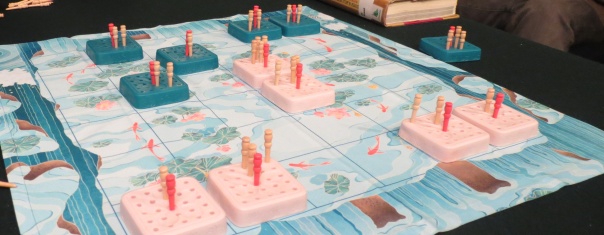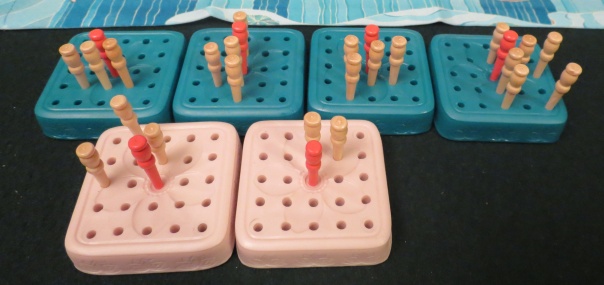More than Surviving
It’s possible to play Thrive faster than it will take you to read this review.
Yes, that might be a statement of how quickly I have lost. What of it?
Abstract games are a real pickle. It’s not only that they’re often given the flimsiest of settings. Although to be fair, Thrive’s setting is as flimsy as its cloth playmat. Something about a koi pond? Warring lotus flowers? Sounds like an excuse to print some pretty artwork and wash your hands of the expectation that a game must be about something.
But I digress. It isn’t only the flimsy setting. It’s the longevity of the thing. Chess is, what, a millennium and a half old? There’s another millennium on top of that for Go? Backgammon goes back five thousand years? That’s so old that even yo momma jokes stop functioning, and that’s the one genre of buffoonery that until this moment knew no hard limit. “Yo momma’s so old she invented backgammon.” See? No self-respecting schoolyard nerd would deploy that one.
Still, it stands that the great abstract games have the advantage of longevity. If we traveled back in time to the days of backgammon, would we find that it existed among hundreds of competitors, one of perhaps thousands of new releases every year, chiseled from stone and bound with animal parts, inked with the same dye used for tattooing flesh? Did it outlast its peers? Was it the best racing game? Or did it wend its way through the ages because nobody decided to improve on that most famous export of Shar-e Sukhteh?
These are the sorts of things I think about when playing Thrive. I expect that this is the product of my narrative-based brain, desperately clawing for some sense of meaning. What is the reason for this conflict? What are we fighting for? Where is Helen, stolen away by Paris to Troy? Do different colors of lotus flowers hate one another?
Thrive is about growth, I think. Perhaps development. Evolution, if I had to substitute for a biology class and couldn’t think of anything better to teach that day. Every piece is the same. Then, as with the blooming of wildflowers, all different. A riot of color. Or in this case, overlapping zones of death. Here is a piece that can leap forward. Another that can move diagonally. Here is a protector, ensuring swift murder upon any who dare assault its nearby counterpart. Over there is a weathered piece, one that can do it all. It’s seen things. Been places. Evaded entrapment on more than one occasion. All different. And they continue to grow apart. After each move, they bloom again. New moves. New defenses. New overlapping zones of death.
Yet it takes perhaps ten seconds to teach. Your goal is to remove all opposing pieces but one. After each move, you install two new pegs into your pieces, which permit new moves. There’s an alternate victory condition in play, one I usually forget about. If both sides have exactly two pieces, the game is won by whichever side first reaches the point where they can’t install both of their pegs. I spent one play trying to actualize this victory condition by keeping two pieces hidden in the corner, adding pegs to them and nothing else. All my other pieces were soon destroyed, my survivors cornered, and my efforts to trick my way into victory scuttled. Back I went, to the pressures of sensing around the edges of my rival’s ever-expanding suite of attacks.
But there are never so many moves that Thrive grows confusing. Clarity is a virtue of abstract design. Here, the board is compact enough that a piece may traverse nearly half of it in one jump, yet that jump will rarely come as a surprise to anyone who’s been observing the skirmish. This pulls the design inward. In chess, it isn’t uncommon to foresee a trade: your piece capturing the opposing piece that will soon capture yours. In Thrive, these exchanges seem to exist at depths normally untouchable by those who have things other to do than play chess. This is a function not only of the board’s compact space, but also of the way your pieces develop. What begins as a piece that can fumble forward eventually grows into a stalwart defender of one piece, then a defender of two, then a piece that can slip sideways as well as cut forward as well as attack at the diagonal as well as function as bait for a more developed predator. If Thrive had scoring the way chess has scoring, would it be based on how many rival pegs are slotted into the pieces you’ve captured, rather than based on the captured pieces themselves?
The result is a paradox. Approachable, yet with the feeling that the silt stirring beneath one’s flippers might rise to reveal an entirely new wellspring beneath the first. Whether this impression leads to a true oasis or a mirage is beyond my ability to deduce. But feelings are important, including those senses of drama and turnabout that hallmark even the supposedly driest of abstract games. In Thrive’s case, the important detail is that it feels deep at the same moment that it feels like mid-level mastery might be within reach from its earliest moments. This should be a contradiction. It possibly is. Can a game be deep and also allow you to explore some cross-section of its depths almost right away? I’m unsure.
For now, Thrive piques my interest in a way that abstract games don’t often accomplish anymore. Perhaps that’s because Thrive is also about self-expression. Those moves, defenses, interlocking zones of death — they’re present on the board because you made them, two pegs after each move, as responses and threats and gambles alike. This also prevents it from becoming too dependent on the prescience of those abstract masters, the ones who, as depicted in television, see future moves as flashes of highlight and a low whoosh sound. More often than expected, I find myself thinking I have my opponent cornered, only to watch them squirm out of my grasp, or sprout spiked tendrils of their own.
In other words, I don’t expect Thrive will be around in five thousand years. But I’m entirely happy that it’s here now.
If what I’m doing at Space-Biff! is valuable to you in some way, please consider dropping by my Patreon campaign or Ko-fi.)
Posted on November 23, 2020, in Board Game and tagged Adam's Apple Games, Board Games, The Fruits of Kickstarter, Thrive. Bookmark the permalink. 6 Comments.





“For now, Thrive piques my interest in a way that abstract games don’t often accomplish anymore.”
That said, you were quite positive about The Duke some years ago. Has it faded into oblivion, or it still keeps its spot as an abstract game you like?
Personally, so called “point salad” games many times feels a lot more abstract to me than abstract games.
You’ll get no argument out of me about most point salad games. Which is one reason I’ve been so pleased with titles such as The Field of the Cloth of Gold and Babylonia — in many ways, they’re point salad games that actually leverage their trickle of points in interesting ways.
As for The Duke, I’m still a fan. I played it a couple of times last year and had a great time.
It’s always great when you know a review will be pure gold just from the above the fold lines.
You know, sometimes I feel like my best reviews are the ones where I go in with no idea what I could possibly write about this thing.
Pingback: Review: Thrive:: More than Surviving (a Space-Biff! review) – Indie Games Only
Pingback: Best Week 2020! Agony, Sheer Agony! | SPACE-BIFF!